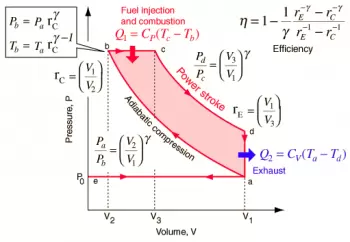
The operating system of heat engines is based on a cycle that is constantly repeating. In the case of internal combustion engines, this cycle consists of:
-
Entry of the air-fuel mixture into the combustion chamber with open intake valve.
-
Fuel combustion - When the piston is at top dead center, the intake valve closes and deflagration of the fuel begins.
-
Expansion of the cylinder: the piston goes down to the lower dead center due to the effect of pressure, generating mechanical work with the valves closed.
-
Expulsion of the gases produced by opening the exhaust valve.
This cycle generates a mechanical movement, if the cycle is repeated we will have a constant mechanical movement.
A heat engine can work through many different cycles. The most common cycles are: the diesel cycle (for diesel engines), the Otto cycle (for gasoline engines), and the Atkinson cycle.
Operating cycles of a heat engine
By operating cycle we understand the succession of operations that the active fluid executes in the cylinder and is repeated periodically. The duration of the operating cycle is measured by the number of strokes made by the piston to carry it out.
In this sense, two types of heat engines are distinguished:
-
4-stroke engine. In the four-stroke engine, the cycle is carried out in 4 strokes of the piston. This engine cycles every two full revolutions of the camshaft.
-
2-stroke engine. The two-stroke cycle is carried out only in 2 strokes of the piston. Two-stroke engines cycle through each turn of the crankshaft.
However, engines have been devised in which the operating cycle is verified in 6 strokes of the piston.
In this particular case, four of the six strokes are used to carry out the same operations of the four-stroke cycle, and the remaining two serve to retain the fuel mixture inside the cylinder in order to allow the fuel, when it is not very volatile, vaporize completely and diffuse into the combustion air, or sweep the cylinder with fresh air.
These engines have not, however, had a practical diffusion.
What are the theoretical cycles of combustion engines and what are they for?
The theoretical cycle of a heat engine is a theoretical approximation of its operation to calculate its performance.
The cycle of an engine is constituted by the physical and chemical transformations that fuel undergoes during its passage inside the engine.
The quantitative examination of these phenomena, taking into account all the numerous variables, represents a very complex problem. Therefore, it is commonly simplified by resorting to theoretical approximations, each of which is based on different simplified assumptions, which have a gradually increasing approximation.
How are the real cycles of heat engines obtained?
The real cycle of a heat engine is obtained experimentally by means of various indicating devices. These devices are capable of recording the diagram of pressures as a function of volumes, in a working power cylinder.
The indicated diagram reflects the actual conditions of the cycle and takes into account the following aspects:
-
Heat losses.
-
Burning time.
-
Losses caused by fluid friction.
-
Duration of valve opening time.
-
Ignition time.
-
Fuel injection and exhaust leaks.